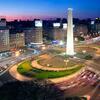The Obelisk: It is considered an emblematic icon of the city and serves as a gathering point for various events and celebrations of sports achievements.
Anyone visiting Buenos Aires cannot miss photographing this icon, strategically located at the intersection of two of the most important avenues: 9 de Julio, which is among the widest in the world, and Corrientes "Street," one of the city's main cultural hubs. The Obelisk is also the central point of the Metrobús, the bus transportation system that crosses the Microcentro via Avenida 9 de Julio, inaugurated in 2013.
Avenida 9 de Julio: With its 140 meters of width, it is known as one of the widest avenues in the world. It is a symbol of Buenos Aires, and with its name dedicated to Argentina's Independence Day, it is a must-see for anyone who wants to capture a quintessential image of the city.
Corrientes Street: The great open-air cultural center of the city, the street that never sleeps, pedestrianized at night and a witness to the golden age of tango, is one of the cultural axes of Buenos Aires. Along its length, you’ll find some of the city’s most important theaters, bookstores, and iconic pizzerias.



